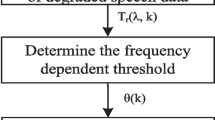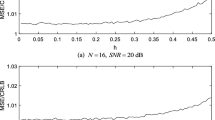Abstract
A channel prediction scheme with channel matrix doubling and temporal-spatial smoothing is proposed. With the assumption that the underlying channel model parameters are unchanged, a virtual doubled channel matrix is constructed to make full use of the intrinsic information contained in the CSI observations, then temporal-spatial smoothing technology is adopted to form the smoothed Hankel matrix, whose rows and columns are mutually space-correlated and time-correlated. After that, the multi-dimensional rotational invariance techniques algorithm is employed to estimate the channel model parameters, and finally time extrapolation is performed on the estimated channel model to predict the future channel state. By channel matrix doubling and temporal-spatial smoothing, the subspace estimation error can be significantly reduced and a more accurate channel model can be obtained, which leads to better channel prediction performance.



Similar content being viewed by others
References
Chen, G., Qiu, L., & Li, Y. (2018). Stochastic geometry analysis of coordinated beamforming small cell networks with CSI delay. IEEE Communications Letters, 20(5), 1066–1069.
Chiu, L. K., & Wu, S. H. (2015). An effective approach to evaluate the training and modeling efficacy in MIMO time-varying fading channels. IEEE Transactions on Communications, 63(1), 140–155.
Abdzadeh-Ziabari, H., Zhu, W., & Swamy, M. N. S. (2018). Joint carrier frequency offset and doubly selective channel estimation for MIMO-OFDMA uplink with Kalman and particle filtering. IEEE Transaction on Signal Process, 66(15), 4001–4012.
Shafin, R., Liu, L., Li, Y., Wang, A., & Zhang, J. (2017). Angle and delay estimation for 3-D massive MIMO/FD-MIMO systems based on parametric channel modeling. IEEE Transactions on Wireless Communications, 16(8), 5370–5383.
Mukherjee, A., & Zhang, Z. (2019). Fast compression of OFDM channel state information with constant frequency sinusoidal approximation. EURASIP Journal on Wireless Communications and Networking, 2019(1), 1–14.
Ahmadipour, M., Seydnejad, S. R., & Barkhordari-Yazdi, M. (2020). Subspace-based deterministic identification of MIMO linear state-delayed systems. Circuits System Signal Processing, 39(3), 4067–4093.
Zhao, N., Yu, F. R., Sun, H., Yin, H., Nallanathan, A., & Wang, G. (2015). Interference alignment with delayed channel state information and dynamic AR-model channel prediction in wireless networks. Wireless Networks, 21(4), 1227–1242.
Jarinova, D. (2013). On autoregressive model order for long-range prediction of fast fading wireless channel. Telecommunication Systems, 52(3), 1533–1539.
Younas, T., Li, J., Tulu, M. M., Munir, H. M., & Liaqat, M. (2020). Study of single-cell massive mimo systems with channel aging and prediction. Wireless Networks, 26(11), 2731–2740.
Liu, J., Jin, X., Fang, D., Liang, H., & Hong, L. (2016). Fading channel modelling using single-hidden layer feedforward neural networks. Multidimensional Systems and Signal Processing, 28(3), 1–19.
Huang, L., Nie, W., Wang, X., & Shen, T. (2017). Feature coefficient prediction of micro-channel based on artificial neural network. Microsystem Technologies, 2017(23), 2297–2305.
Guo, Z., Wang, X., & Heng, W. (2017). Millimeter-wave channel estimation based on 2-D beamspace MUSIC method. IEEE Transactions on Wireless Communications, 16(8), 5384–5394.
Vanderpypen, J., & Schumacher, L. (2007). MIMO channel prediction using ESPRIT based techniques. In 2007 18th IEEE International Symposium on Personal, Indoor and Mobile Radio Communications(PIMRC), (PP. 1-5).
Yan, F. G., Yan, X. W., Shi, J., Wang, J., Shuai, L., Ming, J., et al. (2017). Music-like direction of arrival estimation based on virtual array transformation. Signal Processing, 139, 156–164.
Adeogun, R. O., Teal, P. D., & Dmochowski, P. A. (2015). Extrapolation of MIMO mobile-to-mobile wireless channels using parametric model based prediction. IEEE Transactions on Vehicular Technology, 64(10), 4487–4498.
Adeogun, R. O., Teal, P. D., Dmochowski, P. A. (2017). Channel prediction for millimeter wave MIMO systems in 3D propagation environments. In 2017 24th International Conference on Telecommunications (ICT), (pp. 1–5).
Steinwandt, J., Roemer, F., Haardt, M., & Del Galdo, G. (2016). Deterministic Cramer-Rao bound for strictly non-circular sources and analytical analysis of the achievable gains. IEEE Transactions on Signal Processing, 64(17), 4417–4431.
Steinwandt, J., Roemer, F., Haardt, M., & Del Galdo, G. (2017). Performance analysis of multi-dimensional esprit-type algorithms for arbitrary and strictly non-circular sources with spatial smoothing. IEEE Transactions on Signal Processing, 65(9), 2262–2276.
Bencheikh, M. L., & Wang, Y. (2010). Joint DOD-DOA estimation using combined ESPRIT-MUSIC approach in MIMO radar. Electronics Letters, 46(15), 1081–1083.
Author information
Authors and Affiliations
Corresponding author
Additional information
Publisher's Note
Springer Nature remains neutral with regard to jurisdictional claims in published maps and institutional affiliations.
Rights and permissions
About this article
Cite this article
Sun, D., Li, Y. A Channel Prediction Scheme with Channel Matrix Doubling and Temporal-Spatial Smoothing. Wireless Pers Commun 122, 2045–2055 (2022). https://doi.org/10.1007/s11277-021-08980-5
Accepted:
Published:
Issue Date:
DOI: https://doi.org/10.1007/s11277-021-08980-5




